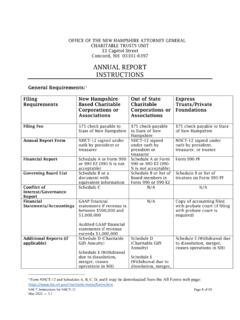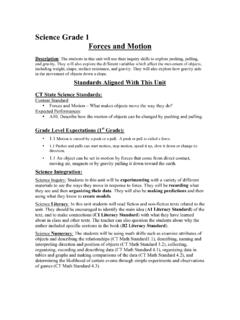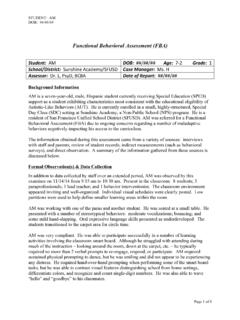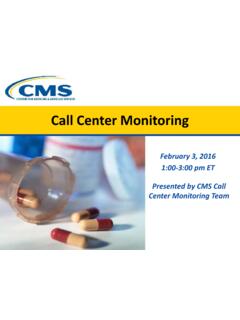Transcription of Updated JCVI advice for vaccinating 5 to 11-year-olds
1 To: ICS leads PCN-led local vaccination services Community pharmacy-led local vaccination Vaccination centres Hospital Hubs and Hospital Hubs+ Chief executives of all NHS trusts and NHS foundation trusts cc. CCG accountable officers All GP practices NHS regional directors NHS regional directors of commissioning Directors of public health All local government chief executives NHS England and NHS Improvement Skipton House 80 London Road London SE1 6LH 18 February 2022 Dear Colleagues, Updated JCVI advice for vaccinating 5 to 11-year-olds The government has accepted Updated advice from the Joint Committee on Vaccination and Immunisation (JCVI) on the vaccination of non at risk 5 to 11 year-olds.
2 The JCVI advises: a non-urgent offer of two 10 mcg doses of the Pfizer-BioNTech COVID-19 vaccine (Comirnaty ) to children aged 5 to 11 years of age who are not in a clinical risk group. The two doses should be offered with an interval of at least 12 weeks between doses. A full copy of the JCVI advice can be found here. This letter sets out the actions we are now asking you to take to begin administering vaccinations to 5 11 year-olds from the beginning of April and highlights the latest advice for 12-year-old children who are still in year 7. In the meantime, assured sites should continue to prioritise the vaccination of 5 to 11-year-olds in a clinical risk group.
3 Classification: Official Publication approval reference: C1591 2 Vaccination of 12-year-olds in Year 7 with Comirnaty 10 micrograms/dose vaccines advice on the vaccine has been Updated so that children who are aged 12 years old in school year 7 should preferably receive the Comirnaty 10 micrograms/dose. This is applicable for any 12 year-old born after 31 August 2009. This will require further changes to PGDs and national protocols. PCN groupings will also need to ensure that Comirnaty 10 micrograms/dose is used if they are vaccinating 12-year-olds in a clinical risk group born after 31 August 2009.
4 The Updated JCVI advice directs that use of the Comirnaty 10 microgram/ dose paediatric formulation should be encouraged for 12-year-olds in year 7, including those who are at high risk. These changes will apply both for 12-year-olds in year 7 who have not already had a first dose, as well as for second doses for those who have received Comirnaty 30 microgram for their first dose. We are planning for the change to be implemented alongside the rollout to the non-at-risk 5-11 cohort at the start of April when the Comirnaty 10 microgram/dose PGD will be available.
5 During February and March, if the Comirnaty 10 microgram/dose is available on site and there is a prescriber available, it will be possible to vaccinate 12-year-olds in year 7 with this formulation under a PSD. If it is not, then it is appropriate to continue to follow Green Book guidance and administer the Comirnaty 30 microgram/ dose for first and second doses to all 12-15 year olds, including those in year 7. Further guidance will be provided in due course. Given this is not a schools based model, SAIS providers are advised to continue vaccinating 12-15 year olds in schools, as they have planned and in accordance with Green Book guidance.
6 ACTIONS NOW REQUIRED Following Updated government advice for the vaccination of 5 to 11-year-olds , systems are now asked to take the following actions: Delivery models and assurance Community pharmacy-led local vaccination services and vaccination centres should be the primary delivery models for this cohort. Sites need to be appropriately assured for vaccinating 5 to 11-year-olds using the Children s Self-Assessment Check List. Sites will 3 also need to undertake a pharmaceutical assurance process before they can use Comirnaty 10 microgram/dose. Only sites with staff trained to the appropriate standards with the relevant competencies will be able to vaccinate this group.
7 PCN groupings are not expected to be the primary delivery model for this part of the programme given the need to reconfigure sites to create an age appropriate offer for 5 to 11-year-olds , current capacity in the programme, and the ongoing workload for general practice. However, assured PCN groupings could be commissioned where there is an assessed need to ensure coverage and/or equity of access. In all situations, PCN groupings that deliver the offer must consider taking on additional appropriately trained staff to support this cohort and continue to maintain their core areas of work caring for their populations.
8 PCN groupings should be continuing to identify and vaccinate 5 to 11-year-olds who are at-risk or who are a household contact of someone who is immunosuppressed, in line with previous advice . Once vaccination for the non-at-risk group is live, families with 5 to 11-year-olds in a clinical risk group may want to have other 5 to 11-year-olds in their care vaccinated at the same time, and so systems should consider putting in place provision to allow this. In addition, and where vaccine would otherwise be wasted, PCN groupings that have not been commissioned to vaccinate non-at-risk 5 to 11-year-olds may vaccinate this group, subject to all the usual rules around consent.
9 Calendars and appointments All assured sites should have their calendars open on the National Booking System (NBS) from 31 March 2022 and the majority of appointments for this new cohort should be offered via NBS. Information about the offer will be issued to parents/ guardians of this cohort in line with the opening of the NBS. There are not expected to be significant changes to the point-of-care systems beyond those that have taken place for the at risk 5 to 11-year-olds that are already being vaccinated. Providers should make sure there is adequate time for families to have conversations about vaccine safety, including taking any opportunities to discuss other vaccinations and immunisations that children may require.
10 The NBS will be Updated to ensure that longer appointment times are enabled for this age group. 4 Queuing time should be kept to a minimum for both booked and walk-in appointments. Operational support to avoid queues is available here. At walk-in sites, families may arrive with siblings of different ages and where possible, eligible family members should be supported to safely receive a dose of the appropriate vaccine. Site preparation Sites should be as child-friendly as possible. Careful consideration needs to be given to child safety and infection prevention and control.
















